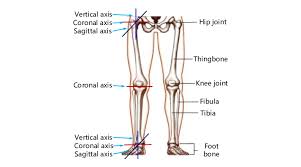
The lower limb is an incredibly vital part of the human body and is responsible for providing the necessary support, mobility, and balance that we need to carry out our daily activities. It is composed of a complex network of bones, muscles, and joints that work together seamlessly to help us move and navigate our environment. Our feet and legs support our entire body weight, making it possible for us to stand, walk, run, jump, and engage in countless other physical activities.
The lower limb is not only critical for our mobility, but it also plays a significant role in our overall health and well-being. The bones and joints of the lower limb are particularly crucial, as they serve as the foundation for the entire structure, providing stability and allowing for proper movement and function.
Without them, even the simplest tasks would be challenging, and our quality of life would be greatly diminished. In this article, we will take a closer look at the anatomy and function of the lower limb, as well as explore the essential role that bones and joints play in its operation.
The lower limb consists of bones that are essential for movement, balance and support. The femur, also known as the thigh bone, is the longest and strongest bone in the human body. It connects the hip bone to the knee joint and helps in supporting the body's weight, as well as assisting in the movement of the leg.
The tibia and fibula are the two bones that form the structure of the lower leg. The tibia plays a critical role in carrying most of the body's weight while standing or walking, and it also plays a vital role in forming the knee joint. The fibula helps in maintaining the balance and stability of the leg.
The patella, or kneecap, is a small bone located in front of the knee joint. It acts as a protector for the knee joint, allowing for the free movement of the leg in various directions. The bones of the feet include the tarsals, metatarsals, and phalanges. The tarsals are a group of seven bones in the foot that form the heel, ankle, and midfoot. The metatarsals and phalanges are located in the front part of the foot that forms the toes.
Common injuries and conditions that affect the bones of the lower limb include fractures, dislocations, sprains, and strains. These can occur from impact or repetitive stress on the bones. Other conditions, like osteoarthritis, can also affect the joints of the lower limb, causing pain and stiffness. In conclusion, the bones of the lower limb are incredibly important for our daily activities. Each bone plays a unique role in supporting the body and aiding in movement, and any disruptions to these bones can lead to significant discomfort and reduced mobility.
The human lower limb consists of multiple joints, including the hip, knee, ankle, and joints of the foot. The hip joint is a ball-and-socket joint, formed by the head of the femur and the acetabulum of the pelvis. It provides stability and support for the weight of the body while enabling a wide range of movements, such as rotation, abduction, and adduction of the leg.
The knee joint is the largest joint in the human body, connecting the femur and the tibia with the patella. It is a hinge joint that allows flexion and extension of the lower leg, as well as some rotation and gliding movements. The ankle joint is a complex joint composed of several bones, including the tibia, fibula, and talus. It allows plantarflexion and dorsiflexion of the foot, as well as inversion and eversion movements.
The joints of the foot include the arches, metatarsophalangeal joints, and interphalangeal joints. They create a stable and flexible base for weight-bearing, walking, and running.
Various injuries and conditions can affect these lower limb joints. For instance, hip osteoarthritis, bursitis, and labral tears are common in older adults, while femoroacetabular impingement (FAI) and hip dysplasia affect young athletes. Knee injuries range from minor strains and sprains to severe ligament tears, such as anterior cruciate ligament (ACL) injuries.
Osteoarthritis is also common in the knee joint, particularly among older individuals. Ankle sprains, strains, and fractures often occur in sports or high-impact activities, while conditions like Achilles tendonitis and plantar fasciitis may develop due to overuse or poor footwear. Proper diagnosis and treatment of these joint injuries and conditions are crucial for maintaining lower limb function and mobility.
Understanding the anatomy and function of the bones and joints in the lower limb is essential for diagnosing and treating injuries and conditions affecting this part of the body. Accurate knowledge of the various components of the lower limb, including the bones, joints, ligaments, and muscles, is critical to identify the causes of pain, discomfort, and mobility issues. Medical professionals, including doctors, physiotherapists, and sports medicine practitioners, leverage this information to develop an effective treatment plan that addresses the root cause of the problem instead of simply masking the symptoms.
The importance of proper exercise and stretching to maintain healthy joints and prevent injuries cannot be overstated. Physical activity is essential to keep the muscles, bones, and joints strong and flexible. By engaging in regular exercise, individuals can improve their mobility, increase their range of motion, and strengthen the supportive tissues around the joints.
Stretching, on the other hand, helps to keep the muscles and ligaments in the lower limb limber, preventing stiffness and reducing the risk of injuries during physical activity. With consistent stretching, the muscles and ligaments around the joints become more resilient, making it easier to maintain proper posture and balance, which are essential for avoiding falls and other accidents.
Overall, understanding the anatomy and function of the lower limb and engaging in proper exercise and stretching habits can help individuals maintain their physical health and prevent injuries and conditions that can cause long-term damage.
The bones and joints of the lower limb are vital for mobility and daily activities, as well as providing structure and support to the body. The femur, tibia, fibula, and patella make up the bones of the leg, while the foot and ankle consist of smaller bones, such as the tarsals and metatarsals. The joints, such as the hip and knee joints, allow for movement and flexibility, while the ligaments provide stability to the joints.
Maintaining the health and function of the bones and joints in the lower limb is essential. Regular exercise, proper nutrition, and safe movement practices can help prevent injury and maintain strength and flexibility. If you experience any pain or discomfort in the lower limb, it is important to seek medical attention. Early diagnosis and treatment can help prevent further damage and improve recovery time.
Ignoring pain or discomfort in the lower limb can lead to more serious health problems, such as osteoarthritis or chronic pain. Seeking medical attention can help identify the source of the problem and provide appropriate treatment, such as physical therapy, medication, or surgery.
In summary, the bones and joints of the lower limb are vital for daily activities and movement. It is important to maintain their health through safe practices and seek medical attention if experiencing pain or discomfort. Taking care of your lower limb can help prevent injury and ensure proper mobility throughout life.






















